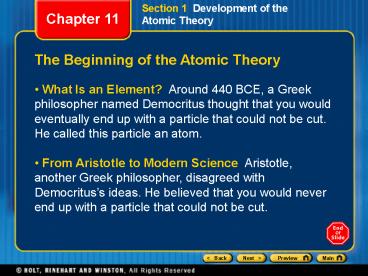Section 1 Development of the Atomic Theory - PowerPoint PPT Presentation
1 / 10
Title:
Section 1 Development of the Atomic Theory
Description:
Section 1 Development of the Atomic Theory Chapter 11 The Beginning of the Atomic Theory What Is an Element? Around 440 BCE, a Greek philosopher named Democritus ... – PowerPoint PPT presentation
Number of Views:96
Avg rating:3.0/5.0
Title: Section 1 Development of the Atomic Theory
1
Section 1 Development of the Atomic Theory
Chapter 11
The Beginning of the Atomic Theory
- What Is an Element? Around 440 BCE, a Greek
philosopher named Democritus thought that you
would eventually end up with a particle that
could not be cut. He called this particle an
atom. - From Aristotle to Modern Science Aristotle,
another Greek philosopher, disagreed with
Democrituss ideas. He believed that you would
never end up with a particle that could not be
cut.
2
Section 1 Development of the Atomic Theory
Chapter 11
The Beginning of the Atomic Theory, continued
- From Aristotle to Modern Science Democritus was
right, though Matter is made of particles, which
we call atoms. An atom is the smallest particle
into which an element can be divided and still be
the same substance.
3
Section 1 Development of the Atomic Theory
Chapter 11
Daltons Atomic Theory Based on Experiments
- Daltons Theory John Dalton published his
atomic theory in 1803. His theory stated that all
substances are made of atoms. Atoms are small
particles that cannot be created, divided, or
destroyed. Atoms of the same element are exactly
alike, and atoms of different elements are
different. Atoms join with other atoms to make
new substances. - Not Quite Correct The atomic theory was then
changed to describe the atom more correctly.
4
Section 1 Development of the Atomic Theory
Chapter 11
Thomsons Discovery of Electrons
- Negatively Charged Particles Thomson
experimented with a cathode-ray tube like the one
shown on the next slide. He discovered negatively
charged particles that are now known as
electrons. - Like Plums in Pudding After learning that atoms
contain electrons, Thomson proposed a new model
of the atom. Thomson thought that electrons were
mixed throughout an atom, like plums in a pudding.
5
Section 1 Development of the Atomic Theory
Chapter 11
6
Section 1 Development of the Atomic Theory
Chapter 11
Rutherfords Atomic Shooting Gallery
- Negatively Charged Particles In 1909, Ernest
Rutherford aimed a beam of small, positively
charged particles at a thin sheet of gold foil.
The next slide shows his experiment. - Surprising Results Rutherford expected the
particles to pass right through the gold in a
straight line. To Rutherfords great surprise,
some of the particles were deflected.
7
Section 1 Development of the Atomic Theory
Chapter 11
8
Section 1 Development of the Atomic Theory
Chapter 11
Where Are the Electrons?
- Far from the Nucleus Rutherford proposed that
in the center of the atom is a tiny, positively
charged part called the nucleus. - Bohrs Electron Levels In 1913, Niels Bohr
proposed that electrons move around the nucleus
in certain paths, or energy levels.
9
Section 1 Development of the Atomic Theory
Chapter 11
Where Are the Electrons?, continued
- The Modern Atomic Theory According to the
current theory, there are regions inside the atom
where electrons are likely to found. These
regions are called electron clouds.
10
Section 1 Development of the Atomic Theory
Chapter 11
Comparing Models of the Atom
Click below to watch the Visual Concept.
Visual Concept































